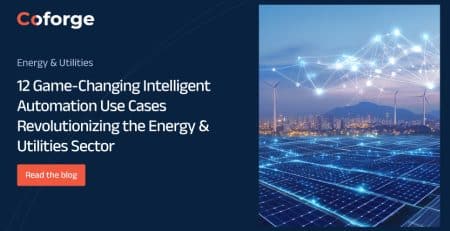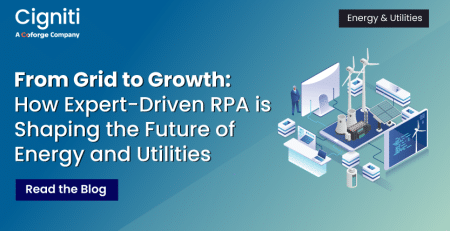The Integration Challenges & Transformative Power of IoT in the Energy & Utilities Sector
|
Listen on the go!
|
According to the U.S. Energy Information Administration (EIA), world energy consumption is forecasted to surge by almost 50% by 2050.
This prediction underscores the urgent need for a concerted global push towards smarter, more efficient energy grids and resource management.
According to the International Energy Agency (IEA), the global Internet of Things (IoT) deployment in power systems is expected to save $80 billion annually from 2016 to 2040, making up 5% of the total global power generation costs.
The IoT has revolutionized sectors like energy and utilities, enabling the integration of smart cities, grids, and utilities for more precise monitoring and management. Through IoT, smart sensors attached to infrastructure offer real-time data on consumption and efficiency, empowering consumers to make informed decisions.
This digital transformation is enhancing operational efficiency and bolstering sustainability efforts. IoT is reshaping how we approach global energy challenges, from optimizing energy usage to detecting leaks in water systems.
Intelligent Grid Solutions:
IoT’s impact on the utility sector is notably exemplified through the introduction of smart grids and advanced energy networks leveraging IoT sensors to monitor electricity usage in real-time. These grids optimize energy distribution by effectively matching supply with demand, thus conserving energy, minimizing outage risks, and facilitating the seamless integration of renewable energy.
Consequently, this fosters a more resilient and environmentally sustainable energy infrastructure.
Efficient Metering Solutions:
IoT technologies have introduced Automated Meter Reading (AMR), revolutionizing how utilities monitor water, gas, and electricity consumption without human intervention. This advancement cuts labor costs and significantly boosts accuracy levels.
Beyond streamlining billing processes, AMR enables proactive identification of issues like leaks or energy theft, allowing timely interventions to minimize waste and lower operational expenses.
Proactive Asset Care:
Unplanned equipment failures can cause substantial downtime, impacting productivity and bottom line of utility firms. Yet, IoT-driven predictive maintenance offers a transformative solution. IoT devices proactively notify operators of impending issues by continuously monitoring equipment status, enabling timely interventions to prevent significant disruptions, thus saving time and cutting maintenance expenses.
Disaster Preparedness:
IoT’s inherent data delivery capabilities in the energy and utilities sector facilitate enhanced communication among grids, nodes, and utility companies. This improved communication enables accurate monitoring and strengthens preparedness for natural and human-induced disasters. With IoT, companies can swiftly identify the root causes of grid failures and anticipate associated challenges.
Moreover, the utilization of data-driven prediction models aids in forecasting potential events, thereby enabling proactive responses. Utilities can enhance grid sustainability and bolster disaster preparedness by leveraging IoT technologies, ensuring more resilient and efficient energy systems.
IoT Data Integration Challenges:
Efficiently integrating IoT data with existing systems presents a significant challenge across the energy and utilities industry. The sheer volume of data generated by IoT devices and disparities in data formats can lead to inconsistencies and inefficiencies. Implementing advanced data integration tools and robust data quality management protocols is crucial to ensure accurate and consistent data across all systems.
Scalability Optimization Solutions:
As organizations incorporate IoT solutions into their operations, scalability and performance issues may arise. Legacy infrastructure may struggle to handle the increased workload and data traffic, impacting overall system efficiency.
Implementing a phased approach to integration, along with infrastructure upgrades and optimization, helps mitigate scalability challenges and maintain optimal performance levels.
Security Concerns and Potential Vulnerabilities:
Ensuring robust security measures is essential when integrating IoT with existing systems. Legacy systems may lack modern cybersecurity features, leaving them vulnerable to new threats introduced by IoT devices.
Conducting thorough security assessments and implementing advanced security measures such as encryption and intrusion detection systems are vital to mitigate cyber risks effectively.
Complex Systems:
The complexity of existing systems poses a significant obstacle to IoT integration across different sectors. These systems may have been customized over time to meet specific business needs, making them incompatible with standard IoT integration solutions. Expertise in IoT technologies and existing systems is necessary to develop tailored integration strategies that accommodate system complexity effectively.
Standardization Challenges:
The lack of standardization in communication protocols and data formats complicates IoT integration efforts. Establishing unified communication protocols and implementing data normalization processes are essential to facilitate seamless communication and integration between disparate systems and devices.
Compatibility Upgrades:
Upgrading existing systems for compatibility with IoT devices requires careful planning and execution. Older hardware and software may not support the requirements of modern IoT technologies, necessitating gradual upgrades and the development of interfaces to bridge compatibility gaps.
Cost-Benefit Considerations:
Balancing the costs of IoT integration with anticipated returns is a critical aspect of implementation across industries. Upfront costs, including hardware upgrades and software development, can be substantial, making a thorough cost-benefit analysis essential. Implementing integration in phases allows for a more manageable financial impact and enables ongoing evaluation of return on investment.
Cigniti at DISTRIBUTECH International 2024:
As a proud sponsor, Cigniti invites you to the DISTRIBUTECH International conference from February 27-29 in Orlando, Florida. Engage with Cigniti’s top Energy and Utility SMEs at booth #4452 to discuss the implementation, integration, and operation of microgrid systems in a modern context, alongside exploring the endless possibilities that AI offers for your existing infrastructure.
Secure your complimentary pass now – bit.ly/4btCdBB
Why Cigniti?
Cigniti has strategically developed a range of base accelerators and utilities tailored for IoT testing, effectively addressing integration challenges in this domain. Our comprehensive offerings, including the IoT Testing platform and IoT Assurance Framework, empower delivery teams to seamlessly incorporate IoT testing into their processes. Our resources are readily available within our IoT testing lab, positioning Cigniti as a key partner for clients across various sectors.
From custom IoT solution developers to automotive OEMs and Tier-1s, our IoT solutions cater to a diverse clientele committed to sustainability. This includes equipment OEMs in industrial, electrical, and mechanical industries, IoT platform vendors, software vendors with IoT applications and platforms, and major SI’s exploring sub-contracting options.
Our specialized tools and expertise empower organizations to navigate the complexities of IoT integration confidently and efficiently and contribute to developing and deploying sustainable and environmentally conscious IoT solutions. We prioritize eco-friendly practices and technologies, ensuring our clients’ IoT implementations align with sustainability principles for a greener and more responsible future.
Learn more about our digital engineering and assurance services for energy and utilities.





Leave a Reply